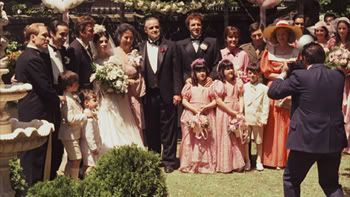The Godfather
The Godfather. A cultural cornerstone of cinema. From the opening scene where the camera zooms out and the character Bonasera (Salvatore Corsitto) starts his “I believe in America” speech, I knew I was in for a treat. Simply put, the Godfather is an American icon to be cherished.
It is hard to beat the oft quoted phrase “best film ever been made," because it’s darn close. However, much to my dismay, there are many in my generation that don’t appear to enjoy it. They find it “boring.” Dull is an phrase I hear from quite a few people who don’t like the film. I don’t know what people expect anymore from movies. It is a very well-made film and a very well-acted film. It’s a film to appreciate its achievement in cinema. The characters were believable and very engaging. Brando presents a believable, realistic picture of a human crime boss, a far cry from the portrayal of 1930s gangsters. Gangsters who would spout “Seeeee?” at the end of just about every sentence, and would say “Coppa” when they talked about police officers. See? The results in this film fly in the face of all the stereotypes that came decades earlier.
The characters were believable and very engaging. Brando presents a believable, realistic picture of a human crime boss, a far cry from the portrayal of 1930s gangsters. Gangsters who would spout “Seeeee?” at the end of just about every sentence, and would say “Coppa” when they talked about police officers. See? The results in this film fly in the face of all the stereotypes that came decades earlier.
The cast fit their roles perfectly. Each character hits their mark perfectly. They feel like they’re an actual family. Marlon Brando stars as Don Vito Corleone, the head of the Corleone family; Al Pacino is Vito’s son, Michael Corleone; James Caan, Vito’s oldest, Santino 'Sonny' Corleone; John Cazale, is Vito’s middle child; Robert Duvall as Tom Hagen, Vito’s adopted Irish/German child; Diane Keaton is Michael’s love interest, Kay Adams; Richard Castellano as Peter Clemenza; Abe Vigoda as Sal Tessio; and Talia Shire is Vito’s daughter Connie Corleone Rizzi.
The story begins in post World War II New York City, 1946. Don Vito, head of the Corleone family, is granting the requests of invitees to his daughter, Connie’s wedding. This opening sequence brings us into the world that the Godfather takes place in. The story is about great families competing for prestige, power, and money.
One of the biggest complaints about the actual film, beyond the “it’s boring” complaint is that the film romanticizes crime and criminals. Yes, on the surface this appears true. The film makes it appear that crime ‘pays.’ When one looks deeper into the film, it starts to become clear that this is not quite the case. The Corleone family, while shown to be the “good guys” in the film, with both the FBI (taking pictures at the wedding at the start of the film) and other mobsters portrayed as the “bad guys,” it is not so clear that the Corleone family is also actually “bad.” They do inexcuasable things, things that they don’t appear to have any moral qualms about killing people, stealing, and distributing drugs (though Vito doesn’t want it distributed to children). That eventually begs the question, why should we care what happens to a bunch of criminals?
The movie ignores the petty, generic crimes that gangsters in early 30s films took part in. There are no heists, no central plot on gambling rackets, no everyday business. I think anyone who believes that the filmmakers are apologists for this deviant criminal behavior are being simple minded and intentionally obtuse about the themes in the film.
Nino Rota’s score is almost haunting in its heartbreaking and heartwarming at the same time. Gordon Willis’ cinematography is brilliant. It’s perfect. The film’s lighting, coloring, and framing is perfect and brilliant.
One must thank Robert Evans at Paramount, and the very fact that the Godfather was a best selling book that we were so honored to end up with this film at all.
The film is, at the very least, a must-see – at the very least because it is so highly regarded, at best because it’s a cornerstone and cultural achievement that few other films have ever been able to achieve.
***** out of *****

No comments:
Post a Comment